This was published 1 year ago
New Zealand’s wild west is stunning and untouched
By Julie Miller
Nature has been hard at work in her sculpture garden on the West Coast of New Zealand’s South Island, with a tendency towards violence in her creative vision. Jammed between the jagged jaws of the Southern Alps and the brooding Tasman Sea, this verdant, 600 kilometre-long, 50 kilometre-wide coastal plain is slashed by ancient rivers of ice and pounded by merciless waves, creating dramatic vistas steeped in mythology.
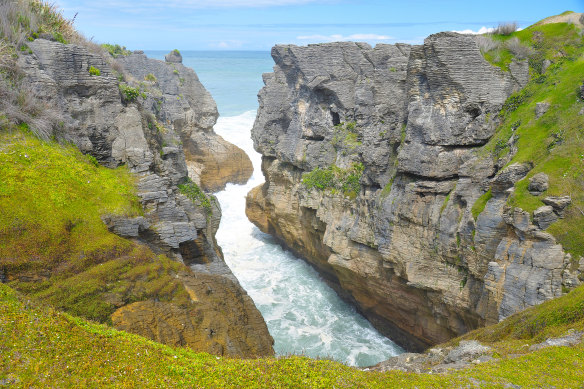
Pancake rocks in Punakaiki.Credit: iStock
To its Maori inhabitants, the region is known as Te Tei o Poutini – “the tides of Poutini” – named after a taniwha (or water monster) that swims along the Pacific coast, guarding its people and the spiritual essence of the sacred greenstone found in its rivers. To others, it’s simply “the Coast” – a remote, untamed frontier that’s sparse in population but rich in scenic and mineral treasures, as well as harbouring 25 per cent of Aotearoa’s conservation land.
Like many of the West Coast’s 1.5 million annual overnight visitors, I’ve travelled across the South Island from Christchurch on the TranzAlpine Railway, accompanied by my nine-year-old granddaughter Ellie who is wide-eyed at the snow-capped peaks, braided rivers, vertiginous gorges and the 16 tunnels that flash by on the five-hour cross-country train trip. Arriving at the penultimate stop, Moana, we drink in the lakefront scenery from the historic Lake Brunner Hotel, refuelling on beer-battered fish fillets under the glassy gaze of taxidermy stags – a somewhat fitting introduction to the wild, wild west!
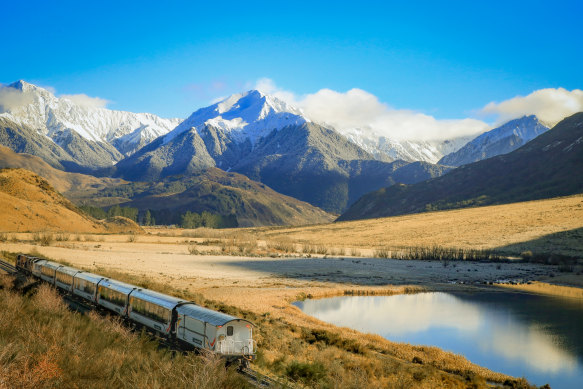
On board the TranzAlpine passing the peaks of the Southern Alps.
Pancakes and beer
Later, we feast on pancakes – but not the fluffy, edible kind. Forty-four kilometres north of Greymouth, along the Great Coast Road – named one of the Top 10 Coastal Drives in the World by Lonely Planet – is a bizarre geological formation: limestone rocks created 30 million years ago when tiny shell fragments were compacted between layers of silt, uplifted by tectonic forces, and etched by the elements into horizontal grooves to resemble stacks of pancakes.
Meanwhile, the surging tide that pummels the rocky promontory erupts through vertical air shafts in undersea caverns with a booming “whoosh”, an entertaining and humbling reminder of the ocean’s fury. Ellie squeals with delight as she dodges a projectile of sea spray, scampering along the 1.1-kilometre boardwalk in an effort to stay warm in the biting coastal breeze.
A warming open fire awaits, however, back in Greymouth at the town’s most beloved icon – Monteith’s Brewery. Said to be the original home of craft brewing in New Zealand, dating to 1868, the Greymouth gastropub suffered a major blow in 2020 when commercial operations were moved to Auckland, leaving the West Coast site with just the restaurant and its popular brewery tour – sans beer production. After dinner, we are shown around the ghostly bottling plant by a guide sharing tales of its economic heyday, when the malty brew became woven into the fabric of the West Coast culture.
Gold in them thar hills
After gold was discovered in the rivers of the West Coast in 1864, this remote part of New Zealand was suddenly not so sleepy as 30,000 optimists and gamblers crossed the Alps to try their luck in the goldfields. During this time, there were more than 300 pubs along the coastline – 84 of them alone in one street of Hokitika.
Just south of Greymouth, Shantytown Heritage Park relives those boozy, brawling days, with faithfully recreated buildings, heritage train rides and gold panning demonstrations. After swishing and swirling, Ellie is convinced she’s struck it rich with her paltry haul of gold flakes; she’s also thrilled to discover a miniscule pebble of greenstone in her souvenir vial.
Further south, in the village of Hokitika, it soon becomes apparent that this is where the wealth of the region now lies – in the sale of precious greenstone, or pounamu. It seems every second shop in town either sells the jade-green jewellery or is an artist’s workshop where skilled carvers create custom pendants, designs guided by the stone’s own energy. In keeping with the mythology surrounding pounamu, we learn that you should never buy or carve the stone for yourself – it should always be a gift between two people.
Wild food, wild scenery
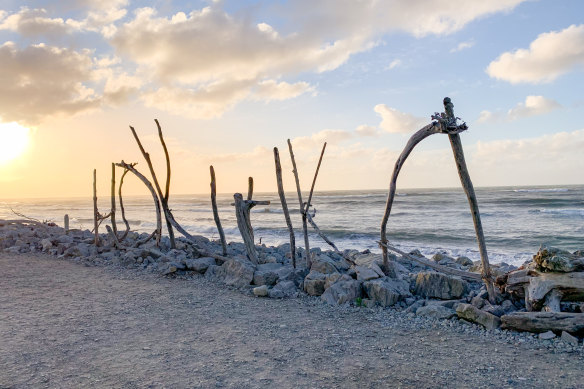
Hokitika arty side comes through at the beach in driftwood lettering.Credit: iStock
Known as the “Cool Little Town”, Hokitika is a hub for artists and foodies, with its annual Wildfoods Festival celebrating the weird and wacky flavours of the West Coast – including dubious delights such as huhu grubs, lamb’s testicles, locusts and horse semen.
While we’re happy to stick to more conventional organic ingredients that make up the lauded Hokitika Sandwich Company’s lunchtime fare, we do tantalise our tastebuds with another local speciality – whitebait, generously scattered over garlic-laced pizza at Fat Pipi’s Pizza. Meanwhile, the historic Theatre Royal Hotel at Kumara – the West Coast’s only fully-restored gold miners’ hotel – is well worth the 15-minute drive, its authentic old west vibe matched by an impressive a la carte menu.
The beachfront at Hokitika is marked by a signature sign created from driftwood, scattered in profusion along its evocative black sand beach. Like little Anna Paquin in The Piano, Ellie cartwheels along the shoreline, pausing to pocket colourful pebbles worn smooth by the lapping tongues of icy wash. She targets pure white quartz, translucent when held to the setting sun; while a shiny green rock may even be a gift from Poutini himself. As the Maori legend says, you don’t find the greenstone, the greenstone finds you…
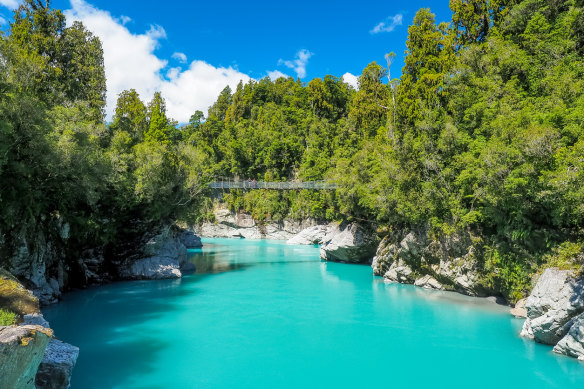
The surreal turquoise waters of Hokitika Gorge.Credit: iStock
In the jewel box of Hokitika, however, nothing dazzles more than the turquoise waters of Hokitika Gorge, a vibrant pop of colour gauged into a scenic reserve in the town’s hinterland. An easy two-kilometre trail leads through mature podocarp forest, with several viewing platforms as well as two suspension bridges adding a theatrical touch to gorge crossings.
With the highest rainfall in New Zealand, the soaring temperate rainforests of the West Coast provide a lush and sheltered environment for Aotearoa’s precious birdlife, including tui, bellbird and the kereru native wood pigeon. At the West Coast Treetop Walk, we explore the ancient Rimu and Kamahi tree canopy on a 450-metre steel boardwalk; while further south at Okarito Lagoon, we paddle around estuarine wetlands where the famed white heron finds sanctuary, with the surrounding forest also the last stronghold of the rare rowi kiwi.
“Humans have only impacted on New Zealand’s environment for the past 1000 years,” Okarito Kayak owner Baz Hughes says as our paddles cut the still waters, reflective with the distant snow-capped tiara of Mount Cook and Franz Josef Glacier.
“More than 80 per cent of the land of the West Coast is under conservancy – so what you’re seeing here is probably as close to what you’d have seen pre-European settlement.”
Glacier Country
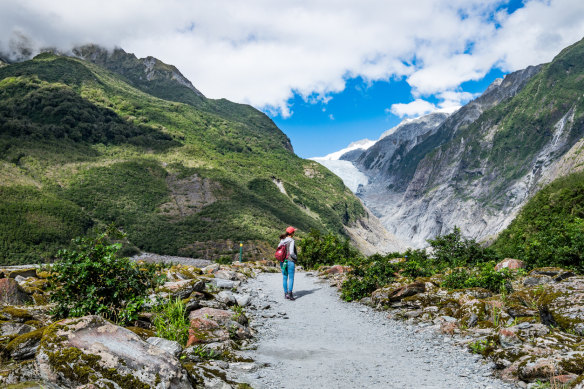
Franz Josef Glacier is a highlight, but the glacier is retreating due to climate change.Credit: iStock
But even a pure landscape like this faces challenges beyond any conservation measures. The West Coast’s biggest attraction – the Fox and Franz Josef glaciers, ancient rivers of ice that protrude beneath the snowline almost to the sea – are rapidly diminishing under the effects of climate change, melting seven times faster than they were 20 years ago.
At the Franz Josef Forest Walk viewpoint, an interpretive board shows visuals of just how far the ice has retreated – in fact, in 1908, the glacier ended at the lookout, with the jagged icefields a distant shadow of their former self.
From the air, however, the iridescent blue glacial grooves and peaks are still a wonderland straight out of Frozen, Ellie’s eyes shining with delight as the helicopter dips and soars over Elsa’s icy kingdom. To have the opportunity to experience the nuances of this landscape, to learn about its threats and the importance of stewardship at such a young age, is a gift I’m grateful to have been able to bestow on her.
The planet, I’m hoping, is in good hands.
DETAILS
Fly + rail
Air New Zealand flies from Sydney and Melbourne to Christchurch International Airport, with domestic transfers to Hokitika on the West Coast. See airnewzealand.com.au
The TranzAlpine train runs between Christchurch and Greymouth. See greatjourneysofnz.co.nz
Stay
In Greymouth, the Copthorne Hotel Greymouth provides comfortable accommodation in a central location from $NZ119 ($108) a night. See millenniumhotels.com
In Hokitika, the Hokitika Fire Station offers stylish self-contained apartment accommodation from $NZ189 ($172) a night; while Shining Star Beachfront Accommodation offers grandstand sunset views over the Pacific Ocean from $NZ125 ($113). See accommodationwestcoast.co.nz
Do
Shantytown Heritage Park, see shantytown.co.nz
West Coast Treetop Walk, see treetopnz.com
Okarito Kayaks, see okarito.co.nz
The Helicopter Line, Franz Josef, see helicopter.co.nz
Julie Miller travelled as a guest of Development West Coast.
Sign up for the Traveller Deals newsletter
Get exclusive travel deals delivered straight to your inbox. Sign up now.